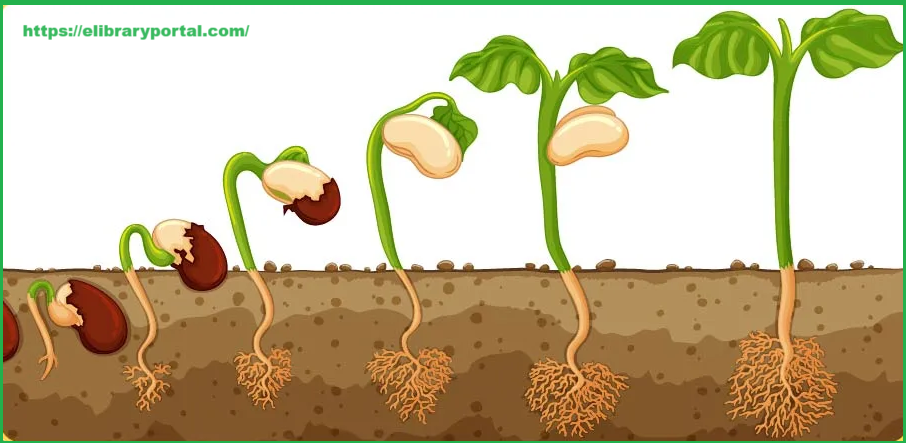In the realm of flowering plants (angiosperms), reproduction can occur through various mechanisms. Among these, apomixis and polyembryony are two intriguing processes that enable plants to reproduce without the typical sexual reproduction mechanisms involving fertilization. Understanding these processes can illuminate how plants adapt and ensure their survival in diverse environments.
See in Fig:

Apomixis
Definition of Apomixis
Apomixis is a form of asexual reproduction that enables plants to produce seeds without fertilization. In apomictic species, embryos develop directly from the maternal tissues of the ovule, bypassing the need for male gametes. This results in seeds that are genetically identical to the parent plant, effectively cloning it.
Types of Apomixis
Apomixis can be classified into several types:
- Gametic Apomixis: In this type, the embryo develops directly from an unfertilized egg cell. The egg cell undergoes mitotic divisions instead of the usual meiotic divisions, leading to the formation of a diploid embryo.
- Somatic Apomixis: In this case, the embryo arises from somatic cells of the ovule or surrounding tissues rather than from the reproductive cells. The somatic cells undergo changes and differentiate into embryonic tissues.
- Adventitious Embryony: This occurs when embryos form from tissues such as the integument or nucellus of the ovule. These embryos can develop without the formation of seeds and are sometimes called “embryo sacs.”
Mechanism of Apomixis
The process of apomixis typically follows these steps:
- Ovule Formation: The plant produces ovules that contain the egg cell and surrounding tissues.
- Embryo Development: Instead of fertilization, the egg cell undergoes mitosis, resulting in the formation of an embryo.
- Seed Development: The surrounding ovule tissues also contribute to the formation of the seed, which may or may not have an endosperm.
- Seed Dispersal: Once mature, the seeds are dispersed, leading to the establishment of new plants.
Advantages of Apomixis
- Clonal Reproduction: Apomixis allows for the production of genetically identical offspring, ensuring that favorable traits are preserved.
- Rapid Colonization: Plants can quickly establish themselves in new areas, as apomictic seeds can develop without needing pollination.
- Environmental Stability: Apomixis can be advantageous in stable environments where the parent plant is well-adapted, allowing it to maintain its genetic integrity.
Examples of Apomixis
Several plant species exhibit apomictic reproduction, including:
- Dandelions (Taraxacum spp.): Many dandelions reproduce via apomixis, producing seeds that are clones of the parent plant.
- Bermudagrass (Cynodon dactylon): This grass species can reproduce through both sexual and apomictic methods.
- Certain Citrus Species: Some citrus plants can produce seeds via apomixis, contributing to their rapid propagation.
Polyembryony
Definition of Polyembryony
Polyembryony refers to the phenomenon where multiple embryos develop from a single fertilized egg or ovule. In this process, more than one embryo forms within a single seed, resulting in a seed containing two or more genetically identical or distinct embryos.
Types of Polyembryony
Polyembryony can be classified into two main types:
- Simple Polyembryony: This occurs when multiple embryos develop from a single fertilized egg. The embryos may be genetically identical, originating from the same zygote.
- Complex Polyembryony: In complex polyembryony, multiple embryos arise from different cells in the ovule. This can occur due to various factors, including fertilization of multiple egg cells or development of apomictic embryos alongside fertilized embryos.
Mechanism of Polyembryony
The process of polyembryony typically follows these steps:
- Fertilization: Multiple fertilizations may occur within the same ovule, leading to the development of several zygotes.
- Embryo Development: Each zygote begins to develop into an embryo, either from a single fertilized egg or through apomictic mechanisms.
- Seed Formation: As the embryos develop, they are enclosed within a single seed coat, leading to the formation of a polyembryonic seed.
- Seed Dispersal: Once mature, the polyembryonic seed can produce multiple seedlings upon germination.
Advantages of Polyembryony
- Increased Survival Rate: Multiple embryos in a single seed can enhance the chances of at least one seedling surviving in variable environmental conditions.
- Genetic Diversity: In cases of complex polyembryony, genetic diversity may be achieved, which can increase adaptability to changing environments.
- Resource Utilization: Having multiple embryos can allow better utilization of available resources, ensuring that at least some seedlings will establish successfully.
Examples of Polyembryony
Polyembryony is observed in various plant species, including:
- Citrus Species: Many citrus fruits, such as oranges and lemons, exhibit polyembryony, where multiple embryos develop in a single ovule.
- Mango (Mangifera indica): Mango seeds can contain several embryos, leading to the potential for multiple seedlings.
- Nuts: Some nuts, such as those of certain members of the family Anacardiaceae, also exhibit polyembryony.
Comparative Analysis of Apomixis and Polyembryony
| Feature | Apomixis | Polyembryony |
|---|---|---|
| Reproductive Method | Asexual reproduction without fertilization | Sexual reproduction resulting in multiple embryos |
| Genetic Makeup | Clonal (genetically identical to the parent) | Can be identical or genetically diverse |
| Embryo Formation | Develops from maternal tissues (ovule) | Develops from fertilized egg or multiple fertilizations |
| Advantages | Rapid colonization, preservation of traits | Increased survival, resource utilization |
| Examples | Dandelions, Bermudagrass, Citrus species | Citrus fruits, mango, certain nuts |
Here are 10 key Questions and Answers about Apomixis and Polyembryony in flowering plants:
Here are 10 key questions and answers about Apomixis and Polyembryony in flowering plants:
1. What is apomixis?
Answer:
Apomixis is a form of asexual reproduction in flowering plants where seeds are produced without fertilization. In apomictic plants, embryos develop from maternal tissues of the ovule, resulting in seeds that are genetically identical to the parent plant.
2. How does apomixis differ from traditional sexual reproduction?
Answer:
In traditional sexual reproduction, fertilization occurs when male and female gametes unite, leading to genetic recombination and diversity. In contrast, apomixis bypasses fertilization entirely, producing clones of the parent plant without genetic variation.
3. What are the main types of apomixis?
Answer:
The main types of apomixis include:
- Gametic Apomixis: Embryos develop directly from unfertilized egg cells.
- Somatic Apomixis: Embryos arise from somatic (non-reproductive) cells of the ovule.
- Adventitious Embryony: Embryos form from tissues like the integument or nucellus of the ovule.
4. What is polyembryony?
Answer:
Polyembryony is the phenomenon where multiple embryos develop from a single fertilized egg or ovule. This results in a seed containing two or more embryos, which can be genetically identical or different.
5. What are the two main types of polyembryony?
Answer:
Polyembryony can be classified into:
- Simple Polyembryony: Multiple embryos develop from a single fertilized egg, resulting in genetically identical embryos.
- Complex Polyembryony: Multiple embryos arise from different cells in the ovule, potentially leading to genetically diverse embryos.
6. What advantages does apomixis offer to plants?
Answer:
Apomixis provides several advantages:
- Clonal Reproduction: Ensures the preservation of favorable traits by producing genetically identical offspring.
- Rapid Colonization: Enables plants to establish in new areas quickly without the need for pollination.
- Environmental Stability: Allows for the maintenance of genetic integrity in stable environments where the parent plant is well-adapted.
7. What advantages does polyembryony provide to plants?
Answer:
Polyembryony offers several benefits:
- Increased Survival Rate: Multiple embryos in a single seed enhance the likelihood that at least one seedling will survive in varying environmental conditions.
- Resource Utilization: Allows better utilization of available resources, increasing the chances of successful establishment.
- Genetic Diversity: In complex polyembryony, genetic diversity can increase adaptability to changing environments.
8. Can you give examples of plants that exhibit apomixis?
Answer:
Examples of plants that reproduce via apomixis include:
- Dandelions (Taraxacum spp.): Many produce seeds clonally without fertilization.
- Bermudagrass (Cynodon dactylon): Can reproduce through both sexual and apomictic methods.
- Certain Citrus Species: Some citrus plants can produce seeds via apomixis.
9. Which plants commonly exhibit polyembryony?
Answer:
Polyembryony is observed in various plant species, such as:
- Citrus Species: Many citrus fruits, like oranges and lemons, produce multiple embryos within a single seed.
- Mango (Mangifera indica): Mango seeds can contain several embryos.
- Certain Nuts: Some members of the Anacardiaceae family also exhibit polyembryony.
10. How do apomixis and polyembryony contribute to plant reproductive success?
Answer:
Both processes enhance reproductive success by enabling plants to produce viable offspring without relying solely on sexual reproduction. Apomixis allows for the rapid production of genetically identical plants, ensuring the preservation of successful traits, while polyembryony increases the chances of seedling survival and adaptation, providing a competitive advantage in various environments.






